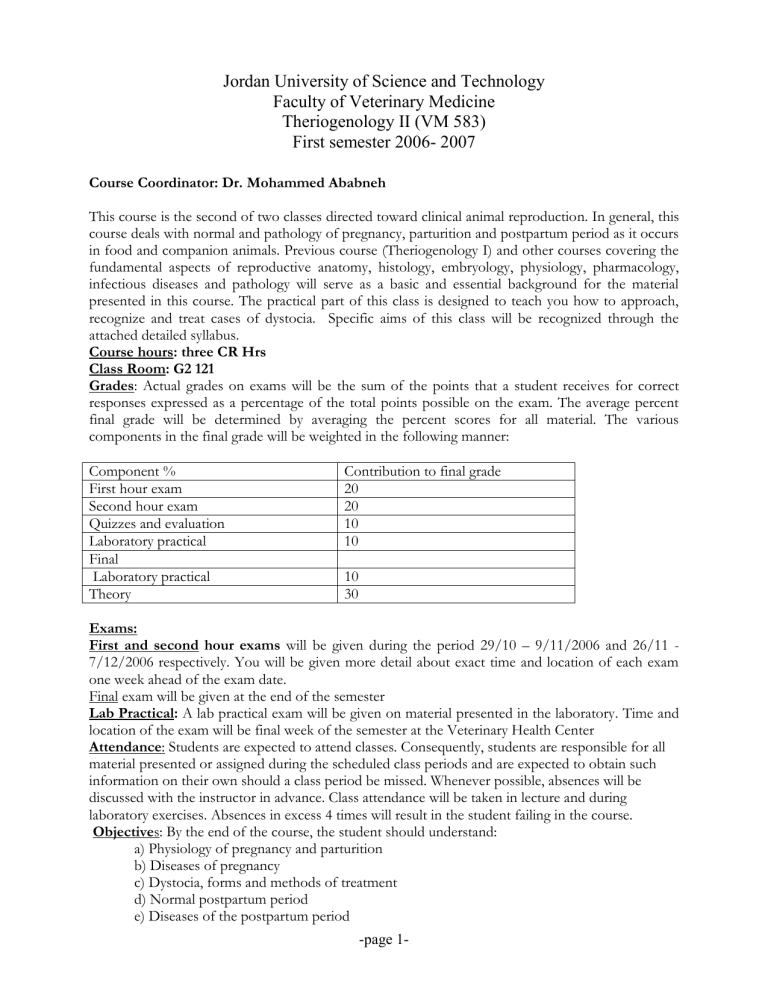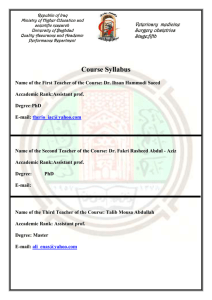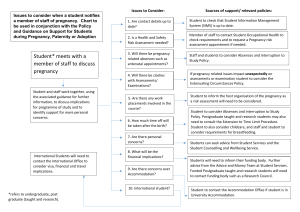Jordan University of Science and technology

Jordan University of Science and Technology
Faculty of Veterinary Medicine
Theriogenology II (VM 583)
First semester 2006- 2007
Course Coordinator: Dr. Mohammed Ababneh
This course is the second of two classes directed toward clinical animal reproduction. In general, this course deals with normal and pathology of pregnancy, parturition and postpartum period as it occurs in food and companion animals. Previous course (Theriogenology I) and other courses covering the fundamental aspects of reproductive anatomy, histology, embryology, physiology, pharmacology, infectious diseases and pathology will serve as a basic and essential background for the material presented in this course. The practical part of this class is designed to teach you how to approach, recognize and treat cases of dystocia. Specific aims of this class will be recognized through the attached detailed syllabus.
Course hours: three CR Hrs
Class Room: G2 121
Grades: Actual grades on exams will be the sum of the points that a student receives for correct responses expressed as a percentage of the total points possible on the exam. The average percent final grade will be determined by averaging the percent scores for all material. The various components in the final grade will be weighted in the following manner:
Component %
First hour exam
Second hour exam
Quizzes and evaluation
Laboratory practical
Contribution to final grade
20
20
10
10
Final
Laboratory practical
Theory
10
30
Exams:
First and second hour exams will be given during the period 29/10 – 9/11/2006 and 26/11 -
7/12/2006 respectively. You will be given more detail about exact time and location of each exam one week ahead of the exam date.
Final exam will be given at the end of the semester
Lab Practical: A lab practical exam will be given on material presented in the laboratory. Time and location of the exam will be final week of the semester at the Veterinary Health Center
Attendance: Students are expected to attend classes. Consequently, students are responsible for all material presented or assigned during the scheduled class periods and are expected to obtain such information on their own should a class period be missed. Whenever possible, absences will be discussed with the instructor in advance. Class attendance will be taken in lecture and during laboratory exercises. Absences in excess 4 times will result in the student failing in the course.
Objectives: By the end of the course, the student should understand: a) Physiology of pregnancy and parturition b) Diseases of pregnancy c) Dystocia, forms and methods of treatment d) Normal postpartum period e) Diseases of the postpartum period
Teaching Style:
Materials will be presented in a lecture format. A case study approach to understanding major principles in reproduction will be utilized during this course. In addition, there will be laboratories in which animals and tissue from animals will be used to demonstrate appropriate concepts.
Grading Procedures:
Exam questions will be of essay type. A legible, organized, concise and grammatically correct answer will be expected in order for credit to be received. Answers should contain information required to explain the concept in question to another undergraduate student. Outlining your answer into pertinent points is acceptable and the suggested method of answering these essay questions provided the interrelationships between points are indicated.
A student missing an exam will be allowed to make up the exam provided that a documented, valid reason for missing the exam exists. Whenever possible, these problems should be discussed with the instructor in advance. A missed exam will be considered as "0".
Food Animal Theriogenology
(Cattle, Sheep and Goat, and Camel)
Instructor: Dr. Abdelsalam Talafha, Diplomate American college of Theriogenology
e-mail: talafha@just.edu.jo
Office hours: Monday 2:30-3:30 Wednesday 2:30-3:30
Textbooks and references
1- Arthur et al., Veterinary Reproduction and Obstetrics -Eight edition, 2001
2- Current Therapy in Large Animal Theriogenology. Youngquist, 1997
3- Handbook of veterinary obstetrics. PGC Jackson, 1995
Lecture Outline:
-Physiology of pregnancy in ruminants i. Periods (Stages) Of Pregnancy in cows ii. reproductive tract and fetal changes during pregnancy iii. Endocrinology of Pregnancy iv. The Bovine Placenta v. Maternal Recognition of Pregnancy vi. Twinning
-Pregnancy Diagnosis i- Pregnancy Diagnosis by Rectal Palpation ii- Pregnancy Diagnosis by Ultrasonography
-Parturition i- Physiology of Parturition ii- Care of the parturient animal and new born iii- Normal puerperium
-Problems During Pregnancy iPrenatal Death iiFetal Mummification iiiStillbirth ivFetal Maceration
vCongenital anomalies and malformations viCervico-vaginal (C-V) Prolapse viiUterine Torsion viiiUterine Rupture ixHydropsical conditions of the fetus and fetal membranes xBovine abortion xiSmall Ruminant abortion
- Conditions That Occur in the Postpartum Period i.
Retained Fetal Membranes ii.
Uterine Infection iii.
Hemorrhage iv.
Lacerations v.
Rupture vi.
Uterine Prolapse vii.
Calving Paralysis viii.
Displaced Abomasum ix.
Mastitis x.
Cystic Ovaries xi.
Metabolic Ddiseases xii.
Postpartum Anestrus xiii.
Repeat Breeder xiv.
Early Embryonic Death
- Dystocia
- Camel Obstetrics
Equine and Small Animal Obstetrics
I nstructor: Mohammed Ababneh, PhD, Dipl ACT
e-mail: ababneh@just.edu.jo
Office hours: Monday 3:45-4:45 Wednesday 3:45-4:45
Textbooks:
1Equine Reproduction. Voss and Mckinnon, 1992,
2Canine and Feline Theriogenology. SD Johnson, MV Root-Kustritz and PN olson. 2001
References:
1- Arthur et al., Veterinary Reproduction and Obstetrics -Eight edition, 2001
2- Current Therapy in Theriogenology. Youngquist. 1997, Publisher Saunders
3- Manual of Small Animal Reproduction and Neonatology. Reprinted 2004
edition. Gillian Simpson, Gary England and Mike Harvey
Lecture Outline:
Equine
-Physiology of Gestation i. Fertilization, Conceptus development and oviductal transport ii. Placental formation iii. Endocrinology of gestation
-Pregnancy Diagnosis
- Abnormalities of Gestation
i- Early embryonic death ii- Placentitis iii- Fetal Death and its consequences (Mummification, Maceration, Abortion) iv- Uterine Torsion v Abdominal muscle edema and rupture vi- Hydropsical Conditions of the fetus and fetal membranes
-Parturition and Puerperium i- Physiology of Parturition ii- Care of the parturient animal and new born foal iii- Normal puerperium
-Dystocia i- Maternal and fetal causes of dystocia ii- Manipulation and treatment of obstetrical cases iii- Postpartum injuries
-Diseases of the puerperium i- Septic and Postpartum Metritis ii- Retained Placenta iii- Trauma and Injuries of the Genital Tract iv- Uterine Prolapse v- Metabolic Disease
Small Animal
- Canine and Feline Pregnancy: Physiology and Diagnosis
- Abortion and Pregnancy Loss
- Canine and Feline Parturition
- Dystocia in the Bitch and Queen
- Periparturient Disorders in the Bitch and Queen
- Termination of Canine and Feline Pregnancy








